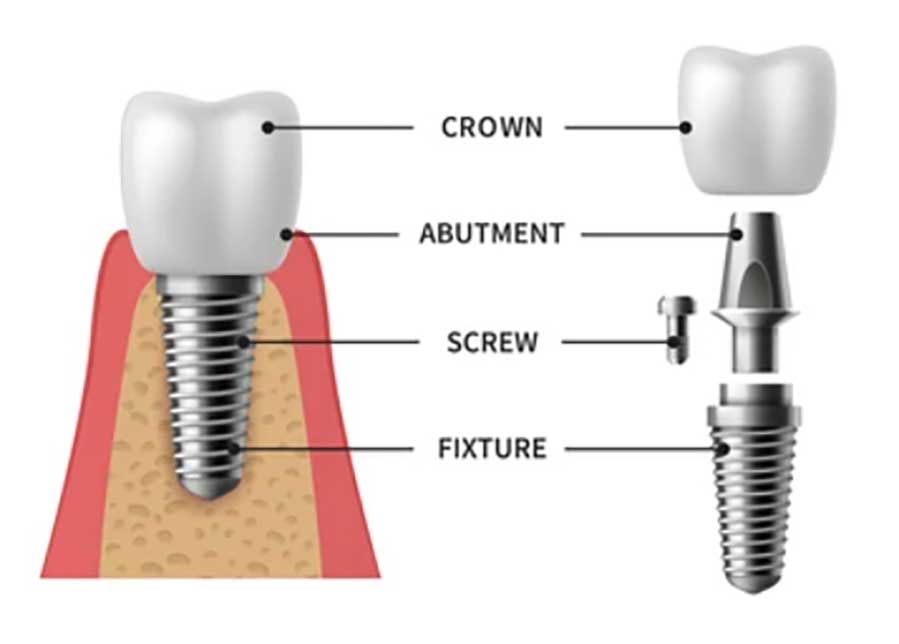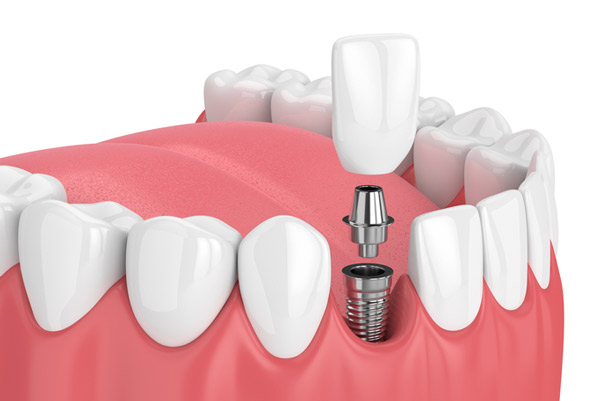Dental Care Galena OH Types of Dental Implants
Dental implants have revolutionized restorative dentistry, offering a dependable alternative to traditional strategies for replacing missing teeth. The integration of dental implants with the jawbone is a fancy organic official statement process generally recognized as osseointegration. This review course of not only anchors the implant securely but additionally helps maintain jawbone health, look at here now stopping the bone loss often related to missing teeth.
The dental implant itself is often made from titanium, a biocompatible material that the body accepts. When an implant is positioned within the jaw, it is designed to intently mimic the basis of a natural tooth, which is crucial for effective integration. The titanium surface encourages the growth of bone cells, enabling the jawbone to bond with the implant over time.
Dental Center Granville OH Understanding Dental Implants: A Comprehensive Guide

Several levels constitute the osseointegration process. Initially, when the implant is surgically placed into the jaw, a therapeutic interval is required for the encompassing bone to start remodeling. During this time, the bone grows around the implant, making a strong and secure basis. This healing time can vary, typically lasting several weeks to a few months, relying on various factors, together with the individual's general health and the specific location of the implant.
The position of surrounding bone quality is essential. High-density bone usually provides a greater setting for osseointegration in comparison with lower-density bone. Specialists often consider the standard and quantity of bone earlier than the implant placement to find out one of the best course of action, which may involve bone grafting procedures in instances of insufficient bone volume. Grafting enhances the possibilities of successful integration by creating a extra strong base for the implant.
The organic mechanisms behind osseointegration contain various mobile activities. Osteoblasts, the cells responsible for bone formation, migrate to the implanted space and begin to put down new bone material. Simultaneously, the floor of the titanium implant undergoes modifications that facilitate this bonding process. Some newer implant designs incorporate floor modifications to further improve biological integration.
Dental Clinic Condit OH Step-by-Step Guide to Dental Implant Procedures
Throughout the mixing course of, the function of blood provide cannot be overstated. An adequate blood supply nourishes the bone and ensures the proper functioning of the cells involved in the therapeutic and integration course of. Improved blood move results in quicker therapeutic and better outcomes, which is why surgical methods and aftercare typically prioritize sustaining or enhancing blood circulation to the positioning of the implant.
Improvements in surgical strategies additionally contribute considerably to the success charges of dental implants - Smile Care New Albany OH. Minimally invasive methods and guided implant surgery allow for more precise placement of implants, lowering trauma to the encircling tissues and doubtlessly dashing up the therapeutic time. The much less trauma experienced by the jawbone can lead to a more favorable setting for osseointegration
Orthodontics Sunbury OH Are Dental Implants Permanent? What You Should Know

How a person maintains their oral hygiene after receiving an implant can significantly influence integration success. Proper care across the implant website helps prevent infections, which can disrupt the therapeutic course of. Regular dental check-ups are also important to watch the health of both the implant and the encircling gum and bone tissues.
Long-term success with dental implants is usually linked to factors corresponding to way of life choices. Patients who smoke or have uncontrolled diabetes could experience lower rates of osseointegration. These conditions interfere with therapeutic and blood supply, making it important for people considering implants to debate their health history with their dentist.
After the profitable integration of the implant, the next section includes inserting the prosthetic restoration, similar to a crown. The ultimate restoration must match comfortably and functionally integrate with the present dentition. Mono Dental Implants Johnstown OH. Proper alignment and occlusion play essential roles in how nicely the implant will perform over time
Dental Clinic Johnstown OH Dental Implant Surgery
Dental implants current a long-lasting solution that helps preserve the integrity of the jawbone. When a tooth is lost, the bone that when anchored its root begins to deteriorate. Implants stimulate the bone equally to natural teeth, triggering the jaw to maintain its density and strength. This stimulation is crucial for preventing the sunken facial appearance that always accompanies tooth loss.
In conclusion, the mixing of dental implants with the jawbone includes a posh interaction of organic and mechanical components. Understanding the osseointegration course of can empower people to make knowledgeable choices about their dental health. By appreciating the significance of selecting a talented dental skilled and adhering to post-operative care, sufferers can obtain optimum outcomes and revel in restored operate and aesthetics for many years to come back.

- Dental implants mimic the structure of natural teeth and supply a steady basis by integrating with the jawbone by way of a course of known as osseointegration.
- The biocompatibility of titanium, generally used for dental implants, performs an important position in promoting successful bonding with bone tissue.
- Osseointegration sometimes begins within a few weeks post-surgery, with the implant surface gradually becoming enveloped by bone cells.
- The mechanical stability of implants is enhanced by their floor roughness, which inspires bone development and improves the mixing process.
- Immediate loading of implants could be feasible in certain circumstances, relying on bone density and the patient’s general dental health.
- Over time, the jawbone responds to the presence of an implant by present process transforming, contributing to the long-term success of the procedure.
- Factors such as oral hygiene, smoking habits, and systemic medical conditions can considerably influence the integration process of dental implants.
- Regular follow-ups and imaging strategies, corresponding to X-rays, might help monitor the success of osseointegration and detect potential complications early.
- The preservation of surrounding bone structure is enhanced by the stimulation provided by dental implants, which may help prevent bone loss in adjacent areas.
- Successful integration not solely restores functionality to the tooth but also contributes considerably to the aesthetics of the patient's smile and facial structure.undefinedWhat are dental implants and how do they work with the jawbone?undefinedDental implants are titanium posts surgically inserted into the jawbone to function synthetic tooth roots. Once placed, they endure a course of called osseointegration, the place the jawbone naturally fuses with the implant, making a stable basis for the replacement tooth.
How does osseointegration occur?undefinedOsseointegration is a biological process the place bone cells grow and connect to the floor of the dental implant. This typically takes several months, during which the implant becomes firmly anchored within the jawbone, ensuring energy and stability for the synthetic tooth.
Dental Center Sunbury OH Understanding Dental Implants: A Comprehensive Guide
What elements affect the success of dental implant integration?undefinedKey components embody the quality and quantity of the jawbone, the patient's general health, and oral hygiene practices. Adequate bone density is essential, as inadequate bone could impede profitable integration.
Is the pain throughout dental implant placement significant?undefinedMost patients report minimal discomfort during the procedure, as local anesthesia is used. Post-operative pain is usually manageable with over-the-counter pain aid drugs, and most discomfort subsides inside a few days.
How long does the combination course of take?undefinedTypically, osseointegration takes about three to six months. However, this can vary based on individual healing processes and the specific conditions of the jawbone.
Can anyone get dental implants?undefinedMost individuals are candidates for dental implants; however, certain conditions similar to uncontrolled diabetes or extreme gum disease could have an result on eligibility. A thorough evaluation by a dental skilled is critical to determine suitability.
Dental Care Associate Pataskala OH Dental Implant Recovery
What could be carried out if there is not sufficient jawbone for integration?undefinedIf there's insufficient bone, procedures like bone grafting can be performed to augment the jawbone. Once the graft heals, dental implants can then be positioned, allowing for successful integration.
Are there long-term care concerns after getting dental implants?undefinedYes, sustaining excellent oral hygiene is vital for the longevity of dental implants. Regular dental check-ups and cleanings also help prevent complications and ensure the ongoing health of the encompassing bone and gum tissue.
Dental Care Condit OH The Advantages, Risks, and Insurance for Dental Implants
How do dental implants compare to other tooth replacement options?undefinedDental implants are sometimes considered superior to dentures and bridges as a outcome of their durability, stability, and the preservation of jawbone health. Unlike other options, implants fuse with the jawbone, which helps keep bone density and facial structure.